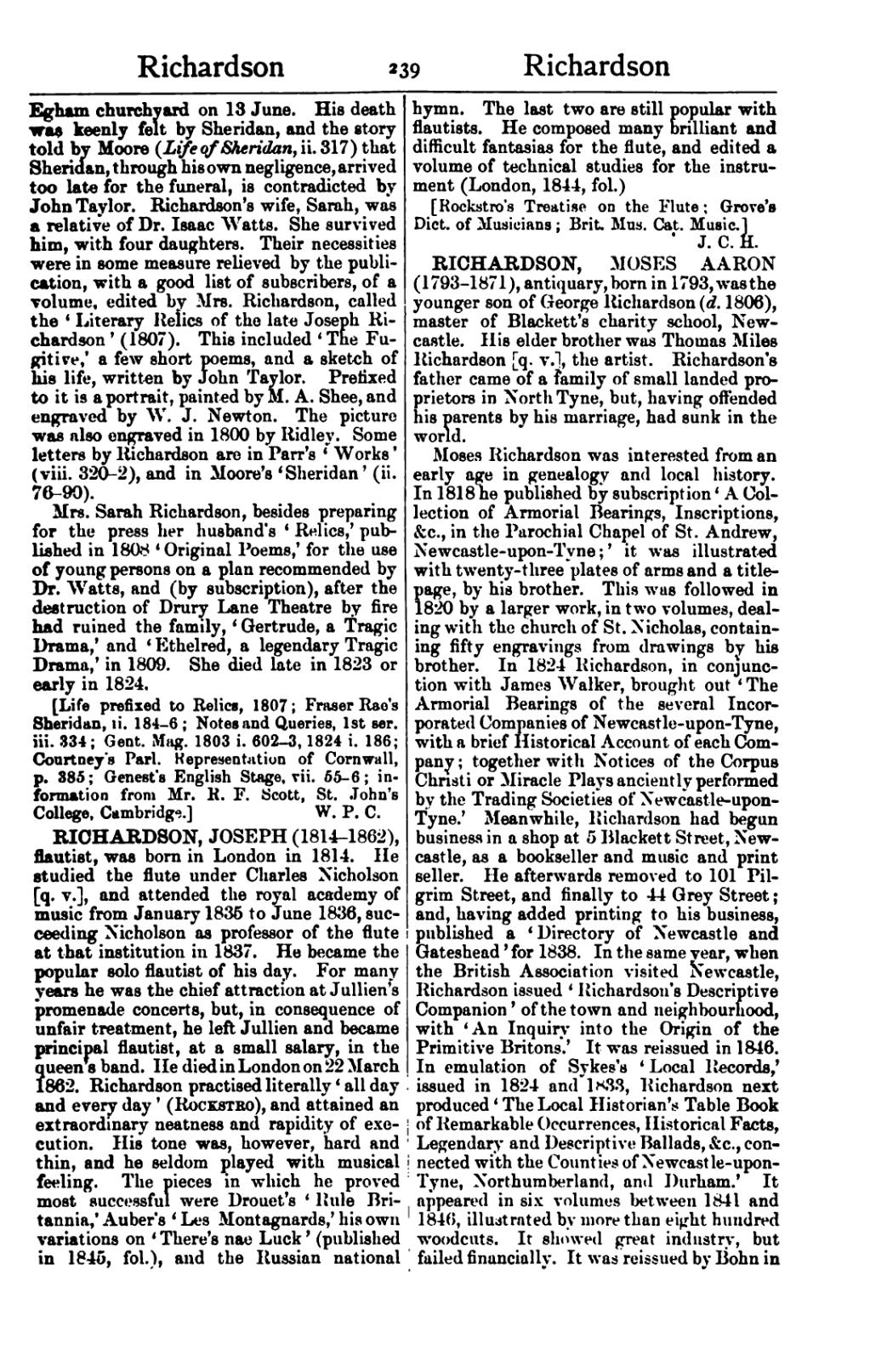Egham churchyard on 13 June. His death was keenly felt by Sheridan, and the story told by Moore (Life of Sheridan, ii. 317) that Sheridan, through his own negligence, arrived too late for the funeral, is contradicted by John Taylor. Richardson's wife, Sarah, was a relative of Dr. Isaac Watts. She survived him, with four daughters. Their necessities were in some measure relieved by the publication, with a good list of subscribers, of a volume, edited by Mrs. Richardson, called the ‘Literary Relics of the late Joseph Richardson’ (1807). This included ‘The Fugitive,’ a few short poems, and a sketch of his life, written by John Taylor. Prefixed to it is a portrait, painted by M. A. Shee, and engraved by W. J. Newton. The picture was also engraved in 1800 by Ridley. Some letters by Richardson are in Parr's ‘Works’ (viii. 320–2), and in Moore's ‘Sheridan’ (ii. 76–90).
Mrs. Sarah Richardson, besides preparing for the press her husband's ‘Relics,’ published in 1808 ‘Original Poems,’ for the use of young persons on a plan recommended by Dr. Watts, and (by subscription), after the destruction of Drury Lane Theatre by fire had ruined the family, ‘Gertrude, a Tragic Drama,’ and ‘Ethelred, a legendary Tragic Drama,’ in 1809. She died late in 1823 or early in 1824.
[Life prefixed to Relics, 1807; Fraser Rae's Sheridan, ii. 184–6; Notes and Queries, 1st ser. iii. 334; Gent. Mag. 1803 i. 602–3, 1824 i. 186; Courtney's Parl. Representation of Cornwall, p. 385; Genest's English Stage, vii. 55–6; information from Mr. R. F. Scott, St. John's College, Cambridge.]
RICHARDSON, JOSEPH (1814–1862), flautist, was born in London in 1814. He studied the flute under Charles Nicholson [q. v.], and attended the royal academy of music from January 1835 to June 1836, succeeding Nicholson as professor of the flute at that institution in 1837. He became the popular solo flautist of his day. For many years he was the chief attraction at Jullien's promenade concerts, but, in consequence of unfair treatment, he left Jullien and became principal flautist, at a small salary, in the queen's band. He died in London on 22 March 1862. Richardson practised literally ‘all day and every day’ (Rockstro), and attained an extraordinary neatness and rapidity of execution. His tone was, however, hard and thin, and he seldom played with musical feeling. The pieces in which he proved most successful were Drouet's ‘Rule Britannia,’ Auber's ‘Les Montagnards,’ his own variations on ‘There's nae Luck’ (published in 1845, fol.), and the Russian national hymn. The last two are still popular with flautists. He composed many brilliant and difficult fantasias for the flute, and edited a volume of technical studies for the instrument (London, 1844, fol.)
[Rockstro's Treatise on the Flute; Grove's Dict. of Musicians; Brit. Mus. Cat. Music.]
RICHARDSON, MOSES AARON (1793–1871), antiquary, born in 1793, was the younger son of George Richardson (d. 1806), master of Blackett's charity school, Newcastle. His elder brother was Thomas Miles Richardson [q. v.], the artist. Richardson's father came of a family of small landed proprietors in North Tyne, but, having offended his parents by his marriage, had sunk in the world.
Moses Richardson was interested from an early age in genealogy and local history. In 1818 he published by subscription ‘A Collection of Armorial Bearings, Inscriptions, &c., in the Parochial Chapel of St. Andrew, Newcastle-upon-Tyne;’ it was illustrated with twenty-three plates of arms and a title-page, by his brother. This was followed in 1820 by a larger work, in two volumes, dealing with the church of St. Nicholas, containing fifty engravings from drawings by his brother. In 1824 Richardson, in conjunction with James Walker, brought out ‘The Armorial Bearings of the several Incorporated Companies of Newcastle-upon-Tyne, with a brief Historical Account of each Company; together with Notices of the Corpus Christi or Miracle Plays anciently performed by the Trading Societies of Newcastle-upon-Tyne.’ Meanwhile, Richardson had begun business in a shop at 5 Blackett Street, Newcastle, as a bookseller and music and print seller. He afterwards removed to 101 Pilgrim Street, and finally to 44 Grey Street; and, having added printing to his business, published a ‘Directory of Newcastle and Gateshead’ for 1838. In the same year, when the British Association visited Newcastle, Richardson issued ‘Richardson's Descriptive Companion’ of the town and neighbourhood, with ‘An Inquiry into the Origin of the Primitive Britons.’ It was reissued in 1846. In emulation of Sykes's ‘Local Records,’ issued in 1824 and 1833, Richardson next produced ‘The Local Historian's Table Book of Remarkable Occurrences, Historical Facts, Legendary and Descriptive Ballads, &c., connected with the Counties of Newcastle-upon-Tyne, Northumberland, and Durham.’ It appeared in six volumes between 1841 and 1846, illustrated by more than eight hundred woodcuts. It showed great industry, but failed financially. It was reissued by Bohn in
